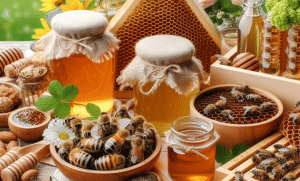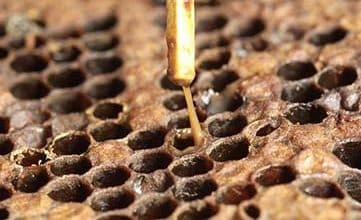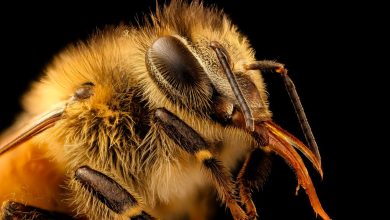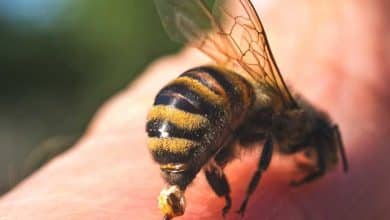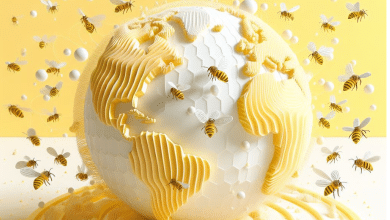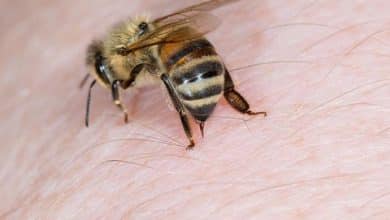Natural Varroa Mite Treatment Eco-Friendly Options for Beekeepers

Varroa Mite Treatment are tiny parasitic mites that infest honey bee colonies. These mites are considered one of the most significant threats to beekeeping worldwide. They attach themselves to adult bees and their larvae, feeding on their hemolymph, which weakens the bees and makes them more susceptible to diseases.
The impact of varroa mites on bee colonies can be devastating. Infested colonies experience reduced longevity and productivity, leading to decreased honey production and weakened populations. The mites can also transmit viruses, such as deformed wing virus, which further compromises the health of the bees.
Beekeepers must be proactive in managing varroa mite infestations to ensure the survival and well-being of their colonies. Traditional methods of varroa mite treatment often involve the use of chemical pesticides. However, there is a growing interest in eco-friendly options that minimize the use of chemicals and promote sustainable beekeeping practices.
By understanding the behavior and life cycle of varroa mites, beekeepers can implement effective treatment strategies to combat these pests. This includes the use of natural treatments such as powdered sugar dusting, essential oils, and organic acids. These methods have been shown to effectively control varroa mite populations while minimizing the negative impacts on bee colonies and the environment.
Overview of Varroa Mites in Beekeeping
Varroa mites are a common problem in beekeeping worldwide. These small parasitic mites infest honey bee colonies and feed on the bees, weakening them and making them vulnerable to diseases. Beekeepers need to understand the behavior and lifecycle of varroa mites in order to effectively manage their infestations.
Varroa mites primarily reproduce in brood cells, where they lay their eggs and feed on the developing larvae. Once the adult bees emerge, the mites attach themselves to their bodies and continue to feed on their hemolymph. This weakens the bees and can lead to deformities in their wings, reduced lifespan, and overall colony decline.
Infestations of varroa mites can have serious consequences for bee colonies. They can spread viruses, such as deformed wing virus, which can further weaken the bees. Varroa mites can also reduce the overall productivity of colonies, leading to decreased honey production and population decline.
Beekeepers must actively monitor and manage varroa mite populations to protect their colonies. This includes implementing varroa mite control measures, such as chemical treatments or eco-friendly alternatives, to ensure the health and survival of the bees. By understanding the challenges posed by varroa mites, beekeepers can take proactive steps to maintain the well-being of their colonies.
Negative effects of Varroa Mites on Bee Colonies
Varroa mites have significant negative effects on bee colonies. They weaken the bees by feeding on their hemolymph, causing deformities in their wings and reducing their lifespan. This weakens the overall colony and can lead to population decline.
Infestations of varroa mites can also have a cascading effect on bee health. These mites act as vectors for viruses, such as deformed wing virus, which further weaken the bees and make them more susceptible to other diseases. This can have devastating consequences for the entire colony.
Varroa mites can also impact the productivity of bee colonies. They feed on developing larvae in brood cells, reducing the number of healthy bees that emerge. This can result in decreased honey production and overall colony decline.
Additionally, varroa mites can disrupt the reproductive cycle of honey bees. They can affect the queen’s ability to lay eggs, leading to a decrease in population growth and the overall health of the colony.
Overall, varroa mites pose a serious threat to honey bee colonies. Beekeepers must actively monitor and manage these infestations to protect the well-being of their bees and maintain the productivity of their colonies.
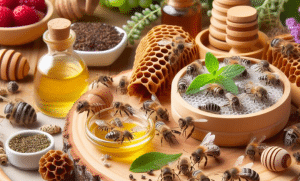
Chemical-Free Methods for Varroa Mite Treatment
When it comes to treating Varroa mite infestations in bee colonies, beekeepers have options that are free from chemical interventions. These eco-friendly methods not only help control Varroa mites but also promote the overall health and sustainability of the colonies.
One such method is powdered sugar dusting. Beekeepers can dust the bees with powdered sugar, which causes the mites to lose their grip and fall off the bees. This non-toxic approach is a popular choice as it doesn’t harm the bees or contaminate the hive. Regular powdered sugar dusting can significantly reduce mite populations.
Another chemical-free treatment option is utilizing oxalic acid vaporization. This method involves vaporizing oxalic acid crystals in the hive, which can kill both adult mites and mites in their reproductive cycle. However, safety precautions must be taken when using oxalic acid to ensure the well-being of the bees.
By using these chemical-free methods in a combination or rotation, beekeepers can effectively control Varroa mites while minimizing the chances of resistance to chemicals. This allows for healthier colonies and reduces the negative impact on bee health.
Using Powdered Sugar Dusting
Powdered sugar dusting is an effective chemical-free method for treating Varroa mite infestations in bee colonies. Beekeepers dust the bees with powdered sugar, causing the mites to lose their grip and fall off the bees. This non-toxic approach is popular among beekeepers as it doesn’t harm the bees or contaminate the hive.
Regular powdered sugar dusting is known to significantly reduce mite populations. However, it is important to note that it is most effective when used in combination with other Varroa management protocols such as drone trapping, queen removal, and the use of organic acids. Using powdered sugar dusting alone may not be sufficient for long-term management of mite infestations.
When using powdered sugar dusting, beekeepers should aim to dust the bees every two weeks for 11 months, using 120g of powdered sugar per application. This consistent treatment regimen can help keep mite populations under control and promote the overall health of the bee colonies.
It is crucial for beekeepers to monitor mite populations regularly and determine the effectiveness of the treatment. If mite levels remain high despite powdered sugar dusting, additional measures may be necessary to manage the infestation effectively.
Powdered sugar dusting is a simple, inexpensive, and eco-friendly method for Varroa mite control that can be easily integrated into a comprehensive Varroa management plan.
Utilizing Oxalic Acid Vaporization
Oxalic acid vaporization is a highly effective method for treating Varroa mite infestations in bee colonies. Beekeepers can use this treatment to significantly reduce mite populations and improve the overall health of their bee colonies.
To utilize oxalic acid vaporization, beekeepers need a vaporizer and oxalic acid crystals. The vaporizer heats the oxalic acid crystals, turning them into a vapor that can penetrate the beehive. The vapor kills the mites by coming into contact with them, causing their demise without harming the bees.
The effectiveness of oxalic acid vaporization lies in its ability to target the mites specifically without causing harm to the bees or contaminating the honeycomb. This treatment can be done during the winter months when the hive is less active and the mite population is at its peak.
It is important for beekeepers to follow safety guidelines when utilizing oxalic acid vaporization. They should wear appropriate protective gear and carefully follow instructions for handling and applying the acid. Beekeepers should also ensure that the treatment is done in a well-ventilated area to prevent inhalation of the vapor.
Oxalic acid vaporization is a natural, chemical-free method for Varroa mite treatment that has proven to be highly effective. By incorporating this treatment into their beekeeping practices, beekeepers can effectively manage mite infestations and maintain the health of their bee colonies.
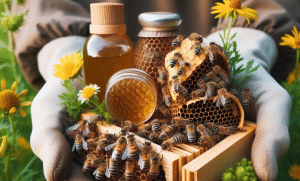
Essential Oils as Natural Varroa Mite Treatment
Essential oils have gained popularity as a natural and eco-friendly method for treating Varroa mite infestations in bee colonies. Among the various options, thymol, which is derived from the thyme plant, is the most commonly used essential oil for Varroa mite control.
Thymol treatment has proven to be effective in controlling mites on both adult bees and brood. Its natural properties make it a preferred choice among beekeepers who aim to minimize chemical interventions in their colonies. Thymol works by disrupting the mite’s nervous system, leading to their demise without harming the bees.
One of the key benefits of using essential oils is their relatively low toxicity to bees and the environment. They offer a natural alternative to chemical treatments, promoting a more sustainable approach to Varroa mite control. Beekeepers should take care to follow the appropriate dosage guidelines and application methods to ensure the safety and effectiveness of the treatment.
It is important to note that while essential oils can be an effective tool in Varroa mite management, they should be used as part of an integrated pest management approach. This means combining multiple methods and regularly monitoring mite levels to ensure long-term colony health. By incorporating essential oils into their beekeeping practices, beekeepers can provide a natural and effective solution to Varroa mite infestations.
Benefits of Essential Oils in Beekeeping
Essential oils offer several benefits when used in beekeeping for Varroa mite treatment. Firstly, they provide a natural alternative to chemical interventions, promoting a more eco-friendly approach to pest control. Beekeepers who aim to minimize the use of synthetic chemicals in their colonies find essential oils to be a preferred option.
Secondly, essential oils, such as thymol, can effectively control Varroa mites both on adult bees and in brood cells. Their natural properties disrupt the mite’s nervous system, leading to their demise without harming the bees. This targeted action helps maintain colony health and productivity.
Furthermore, essential oils have relatively low toxicity to bees and the environment. This makes them a safer option for the overall well-being of the colony and reduces the risk of negative impacts on pollinators and the surrounding ecosystem.
The use of essential oils in beekeeping encourages a more sustainable and integrated approach to Varroa mite management. By incorporating these natural treatments into their beekeeping practices, beekeepers can ensure the long-term health and vitality of their colonies while minimizing the use of harsh chemicals.
Application methods and considerations
Application methods and considerations when using essential oils for Varroa mite treatment in beekeeping include the following:
- Topical Application: Essential oils can be applied directly to adult bees using a spray bottle or a fumigation method. The oil is sprayed onto the bees, targeting the mites that are attached to their bodies. This method allows for direct contact and effective treatment.
- Oxalic Acid Dribble: This method involves mixing oxalic acid with a sugar syrup and dribbling the mixture onto the bees. The bees then distribute the acid throughout the hive, targeting both the adult mites and those in the brood cells.
- Vaporization: Essential oils, such as thymol, can be vaporized and applied to the hive using a vaporizer. The vapor penetrates the hive, reaching the mites and disrupting their nervous system. This method is particularly effective in treating mites within brood cells.
- Considerations: When using essential oils, it is important to follow the manufacturer’s instructions and dosage recommendations. Some oils may require multiple applications for effective treatment. Additionally, timing is crucial as treatments should be done during periods of low brood activity to maximize efficacy. Beekeepers should also monitor the health of their colonies closely to ensure the treatments are working and adjust the treatment plan if necessary.
By carefully considering the application methods and taking into account the specific needs of their colonies, beekeepers can effectively utilize essential oils as a natural Varroa mite treatment option in a safe and sustainable manner.
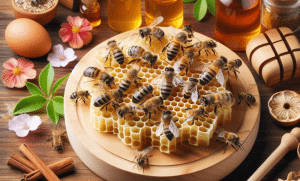
Formic Acid Treatments for Varroa Mite Control
Formic acid treatments have proven to be an effective method for controlling Varroa mites in beekeeping. Recently permitted by the EPA in the United States, this treatment has been utilized by beekeepers in Canada and Europe for many years. It is also the only chemical pesticide approved for organic honey production.
Formic acid occurs naturally in the venom of honey bees and is a component of honey. It is commonly used because it can penetrate wax cappings at high concentrations, effectively killing reproducing mites. This treatment method has shown positive results in reducing Varroa mite infestations and promoting healthier bee colonies.
When implementing formic acid treatments, it is important to follow safety measures and best practices. Beekeepers should only treat colonies after careful monitoring efforts indicate the need for treatment. This ensures that the treatment is applied when necessary and avoids unnecessary exposure to the bees.
Formic acid treatments offer an eco-friendly and sustainable option for Varroa mite control in beekeeping. By utilizing this natural component of honey and applying it in a targeted manner, beekeepers can effectively manage mite populations and promote the overall health of their colonies.
Effectiveness of Formic Acid against Varroa Mites
Formic acid has proven to be an effective treatment for controlling Varroa mites in beekeeping. It is highly effective in killing reproducing mites and reducing infestations within bee colonies.
Studies have shown that formic acid has a strong impact on Varroa mite populations. It can penetrate wax cappings at high concentrations, reaching the mites hidden within the brood cells. This makes it an effective option for eliminating mites in both open and sealed brood.
One of the advantages of formic acid is its ability to kill both adult mites and their offspring. This helps to disrupt the mite’s reproductive cycle and prevent further growth of the population.
Furthermore, formic acid has a short residual effect, which means it dissipates quickly from the hive. This minimizes the potential for residual contamination and reduces the risk of harm to the bees.
Beekeepers must be cautious when using formic acid and ensure that it is applied correctly. Monitoring the mite infestation levels and following the recommended dosage and application methods will help maximize the effectiveness of formic acid treatments.
In conclusion, formic acid is an effective and eco-friendly treatment for controlling Varroa mites in beekeeping. Its ability to penetrate wax cappings and target reproducing mites makes it a valuable tool for promoting bee colony health.
Safety measures and best practices for application
When utilizing formic acid treatments for Varroa mite control, it is essential for beekeepers to prioritize safety measures and follow best practices to ensure the well-being of both the bees and themselves.
First and foremost, beekeepers must always wear appropriate protective gear, including gloves, goggles, and a beekeeping veil, to prevent accidental exposure to formic acid. It is crucial to handle the acid with care and avoid direct contact with the skin, eyes, and respiratory system.
It is recommended to apply formic acid treatments during periods when the colony is less active, such as in the early morning or late evening. This helps minimize disturbances to the bees and reduces the risk of beekeeper and bee interactions.
Proper application techniques should be followed, such as using the correct dosage and applying the acid in a well-ventilated area. Beekeepers should carefully read and understand the instructions provided by the manufacturer before applying formic acid treatments.
Beekeepers should also monitor the temperature within the hive when using formic acid. High temperatures can accelerate the release of formic acid vapors, potentially causing harm to the bees.
By adhering to these safety measures and best practices, beekeepers can effectively and safely utilize formic acid treatments to control Varroa mite infestations, without compromising the health of the bee colonies.
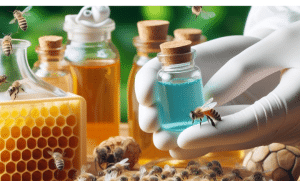
Organic Acids and Organic Treatments
Organic acids, such as formic acid and lactic acid, are commonly used in beekeeping as organic treatments for Varroa mite control. These acids are considered soft chemicals because they are naturally derived, making them a preferred choice for beekeepers who prioritize eco-friendly and sustainable practices.
Formic acid is known for its effectiveness against Varroa mites. When applied properly, it can reduce mite population within the colony. Formic acid treatments are often conducted in the summer when mite reproduction is at its peak. However, beekeepers should follow recommended dosage and application techniques to prevent harm to the bees.
Lactic acid is another organic acid that can be used for Varroa mite control. It is less aggressive than formic acid and is generally well-tolerated by bees. Lactic acid treatments can be applied in the late summer or early fall to target mite populations before winter.
In addition to organic acids, there are other organic treatments available for Varroa mite control. These include essential oils, such as thymol and wintergreen oil, which have shown promising results in reducing mite infestations. However, it is important to note that the effectiveness of organic treatments can vary depending on various factors, including mite resistance and environmental conditions.
By incorporating organic acids and other organic treatments into their Varroa mite control strategies, beekeepers can promote healthier colonies while minimizing the use of harsh chemicals.
Utilizing Formic Acid and Lactic Acid in Beekeeping
Formic acid and lactic acid are two organic acids that beekeepers can utilize in beekeeping as part of their Varroa mite treatment strategies. These acids have shown effectiveness in reducing mite populations within the colonies.
Formic acid is known for its ability to control Varroa mites. It can be applied during the summer when mite reproduction is at its peak. Beekeepers should follow recommended dosage and application techniques to ensure the safety of the bees.
Lactic acid is another organic acid that is well-tolerated by bees. It can be used for Varroa mite control in the late summer or early fall, targeting mite populations before winter.
Both formic acid and lactic acid can be naturally found in honey, making them suitable options for eco-friendly beekeeping practices. However, it is important for beekeepers to accurately measure and apply these acids according to recommended guidelines to avoid any negative effects on the colony.
Utilizing formic acid and lactic acid in beekeeping can help beekeepers maintain healthier colonies by effectively controlling Varroa mites without relying on harsh chemicals.
Other organic treatments for Varroa Mite control
Some other organic treatments for Varroa mite control include thymol and formic acid pads. Thymol is a natural compound derived from thyme that has shown effectiveness in reducing mite populations. It can be used in the form of strips or pads placed within the hive.
Formic acid pads are another organic option for mite control. These pads release formic acid vapor, which helps in reducing the mite population. It is important to follow the recommended dosage and application instructions to ensure the safety of the bees.
Another organic treatment option is using essential oils such as tea tree oil or lemongrass oil. These oils have natural mite-repelling properties and can be applied as a spray or used in a sugar syrup solution.
It is important for beekeepers to carefully consider the effectiveness and safety of these organic treatments before using them. Additionally, it is essential to follow the guidelines provided by beekeeping experts and manufacturers to ensure the health and well-being of the bee colonies.
Varroa mites pose a significant threat to bee colonies and can have devastating effects if left untreated. Fortunately, beekeepers have a range of natural, eco-friendly options for treating these mites.
Chemical-free methods like powdered sugar dusting and oxalic acid vaporization have shown effectiveness in reducing mite populations. These methods are safe for the bees and the environment, making them ideal choices for eco-conscious beekeepers.
Essential oils, such as tea tree oil and lemongrass oil, provide another natural treatment option. These oils have mite-repelling properties and can be used in sprays or sugar syrup solutions.
Formic acid treatments have also proven effective against Varroa mites. While caution must be taken to follow application guidelines, formic acid pads can help reduce mite populations and ensure the health of the bee colonies.
Overall, it is crucial to prioritize eco-friendly treatments to protect the well-being of the bees and the environment. By implementing these natural varroa mite treatment methods, beekeepers can maintain healthier colonies and contribute to sustainable beekeeping practices.
Importance of Eco-Friendly Varroa Mite Treatment
Eco-friendly Varroa Mite Treatment are of utmost importance in beekeeping practices. Using natural methods to control varroa mites helps to maintain the health and well-being of bee colonies while minimizing negative impacts on the environment.
Chemical-free treatments, such as powdered sugar dusting and oxalic acid vaporization, are safe and non-toxic to bees. These methods are effective in reducing mite populations and preventing the development of resistance to chemicals.
Choosing eco-friendly options also avoids the potential contamination of honey and other bee products with chemical residues, ensuring that the end products are safe for consumption. Additionally, these treatments promote the overall sustainability of beekeeping operations by minimizing the use of synthetic chemicals.
By prioritizing eco-friendly Varroa Mite Treatment, beekeepers contribute to the preservation of bee populations and the ecosystem as a whole. It is essential to adopt practices that protect both the health of the bees and the environment they rely on. With natural methods, beekeepers can maintain healthier bee colonies and contribute to the long-term sustainability of beekeeping practices.
Promoting sustainable beekeeping practices for healthier colonies
Promoting sustainable beekeeping practices is essential for maintaining healthier colonies.
By adopting eco-friendly Varroa Mite Treatment, beekeepers can ensure the long-term health and survival of their honeybee colonies.
These treatments not only effectively target varroa mite infestations but also minimize the negative impact on the environment.
By avoiding the use of synthetic chemicals, beekeepers can prevent contamination of honey and other bee products with chemical residues.
This promotes the production of safe, high-quality products for consumers.
Moreover, eco-friendly treatments such as powdered sugar dusting, oxalic acid vaporization, and essential oil applications are safe and non-toxic to the bees themselves.
This means that the treatments do not harm the bees or compromise their overall health and well-being.
By prioritizing sustainable practices, beekeepers can contribute to the preservation of bee populations and the ecosystem as a whole.
A healthy bee population is not only crucial for pollination but also for the overall biodiversity and stability of the environment.
What is the most effective treatment for varroa mites?
The most effective treatment for varroa mites is a combination of different methods. While there is no one-size-fits-all solution, an integrated approach to Varroa Mite Treatment has been proven to yield the best results. This approach typically involves a combination of chemical and non-chemical methods.
One commonly used chemical treatment is oxalic acid vaporization, which has shown high efficacy in reducing varroa mite infestations. It is relatively easy to administer and has minimal impact on the environment. However, it is important to follow the recommended dosage and safety protocols when using this treatment.
Non-chemical methods such as powdered sugar dusting and essential oil applications can also be effective in controlling varroa mites. Powdered sugar dusting involves dusting the bees with powdered sugar, which causes the mites to lose their grip on the bees and fall to the bottom of the hive. Essential oils like thymol can disrupt the mite’s reproductive cycle and deter their infestation.
It is essential for beekeepers to regularly monitor their hives for varroa mite infestations and adjust their treatment strategies accordingly. Consulting with experienced beekeepers, following established guidelines, and staying up to date with research on Varroa Mite Treatment can help beekeepers make informed decisions about the most effective treatment methods for their colonies.
What naturally kills varroa mites?
Varroa mites are a significant threat to bee colonies, but there are natural methods that can effectively kill these pests. One such method is the use of powdered sugar dusting. When bees are dusted with powdered sugar, it causes the mites to lose their grip on the bees and fall to the bottom of the hive. This can help reduce the mite population and prevent further infestations.
Another natural option is the use of essential oils. Certain essential oils, such as thyme oil, have been found to disrupt the reproductive cycle of varroa mites. By applying these oils to the hive, beekeepers can deter the mites and prevent their spread within the colony.
Furthermore, organic acids like formic acid and lactic acid have shown effectiveness in killing varroa mites. These acids are safe for bees when used in the correct amounts and can be applied as treatments to control the mite population.
Overall, using natural methods to kill varroa mites can be a more eco-friendly and sustainable approach for beekeepers. It is important for beekeepers to experiment with different methods and find the most effective treatment for their specific colonies. Regular monitoring and intervention are crucial for maintaining healthy bee populations and preventing the devastating effects of varroa mites.
What is the new treatment for varroa mites?
Beekeepers are constantly searching for new and effective treatments to control varroa mite infestations. One promising new treatment is the use of drone brood trapping. This method involves selectively removing drone brood frames from the hive, which often harbor a high concentration of varroa mites. By removing and freezing these frames, beekeepers can reduce the overall mite population within the colony.
Another innovative treatment is the application of biopesticides, specifically those containing bacteria such as Bacillus thuringiensis. These biopesticides target varroa mites without harming the bees. They work by disrupting the mites’ reproductive cycle, ultimately reducing their numbers and preventing further damage to the colony.
Furthermore, researchers are exploring the use of RNA interference (RNAi) as a potential treatment for varroa mites. RNAi is a biological process that can be used to silence specific genes within the mites, inhibiting their ability to reproduce and infest the colony. While this treatment is still in the experimental stage, it shows promising results for future varroa mite control.
It is important for beekeepers to stay informed about these new treatment options and consult with experts in the field to determine the most suitable approach for their specific circumstances. With ongoing research and advancements, the development of effective and sustainable treatments for varroa mites is a priority in beekeeping.
What month do you treat varroa mites?
In beekeeping, the timing of Varroa Mite Treatment is crucial for effectively managing these pests. The ideal month to treat varroa mites may vary depending on various factors such as geographical location, weather conditions, and beekeeping practices. However, many beekeepers commonly treat for varroa mites during the late summer months.
Late summer treatments, typically in August and September, are preferred because this is when mite populations tend to reach their peak. Treating during this period can help reduce the mite load before winter, ensuring that the colony has a better chance of survival.
Beekeepers often employ a combination of treatment methods during this time, including the use of organic acids, essential oils, and other natural treatments. It is important for beekeepers to closely monitor mite populations and consult with experienced beekeepers or local beekeeping associations to determine the most appropriate treatment strategy for their specific region and hive conditions.
By effectively treating for varroa mites during the right month, beekeepers can help maintain healthier colonies and improve the chances of their bees’ overall well-being and productivity.
As we wrap up our deep dive into eco-friendly solutions for Varroa mite treatment, it’s clear that the VATOREX project is leading the charge towards a sustainable and revolutionary approach. By leveraging the natural principle of different heat tolerances between bees and Varroa mites, VATOREX is paving the way for a safer and more environmentally-friendly future for beekeeping.
I’d love to hear any thoughts or experiences you have with natural Varroa Mite Treatment. What’s the biggest challenge you face in keeping your hives healthy, and what eco-friendly solutions have you tried so far? Your insights could help the beekeeping community at large. Let’s continue the conversation and work towards a world where bees thrive harmoniously with nature!
Thank you for joining us, and stay tuned for more updates and tips on sustainable beekeeping practices.



